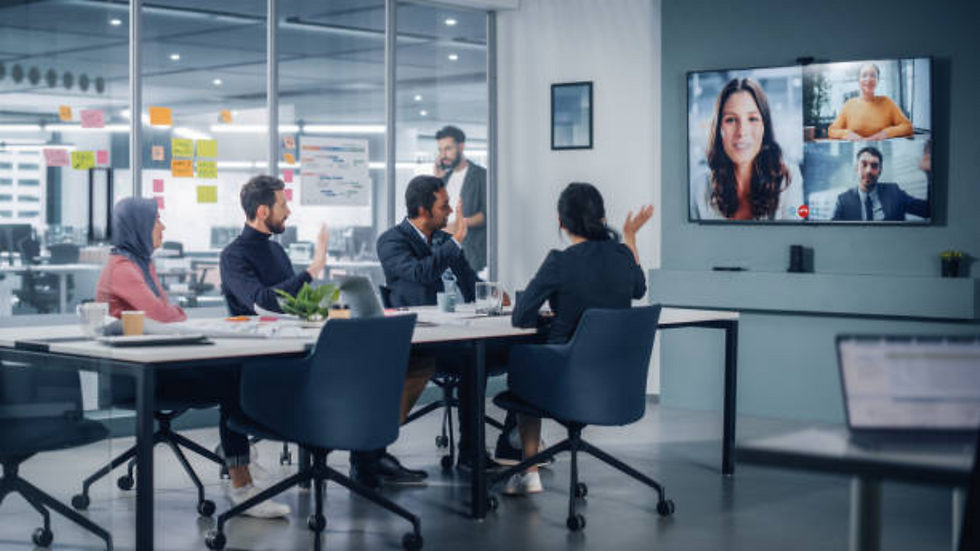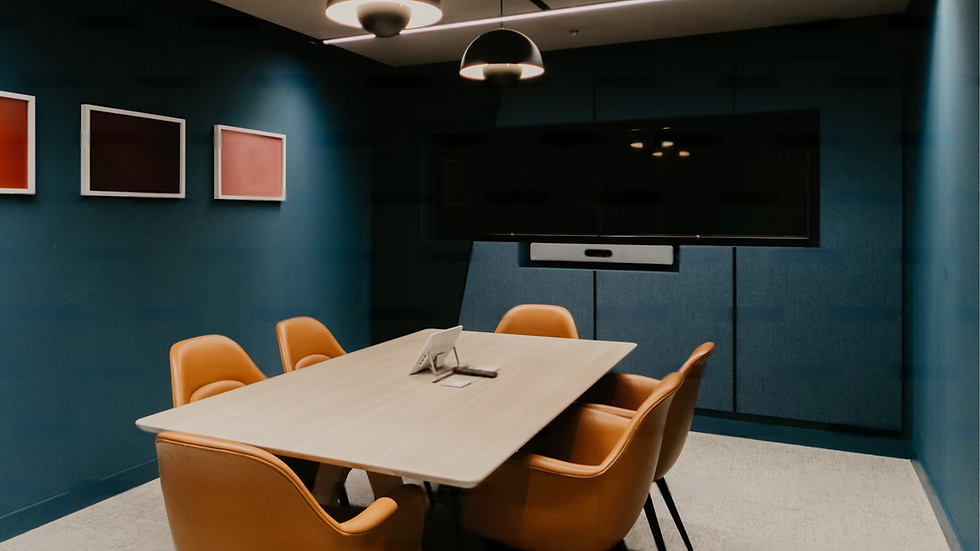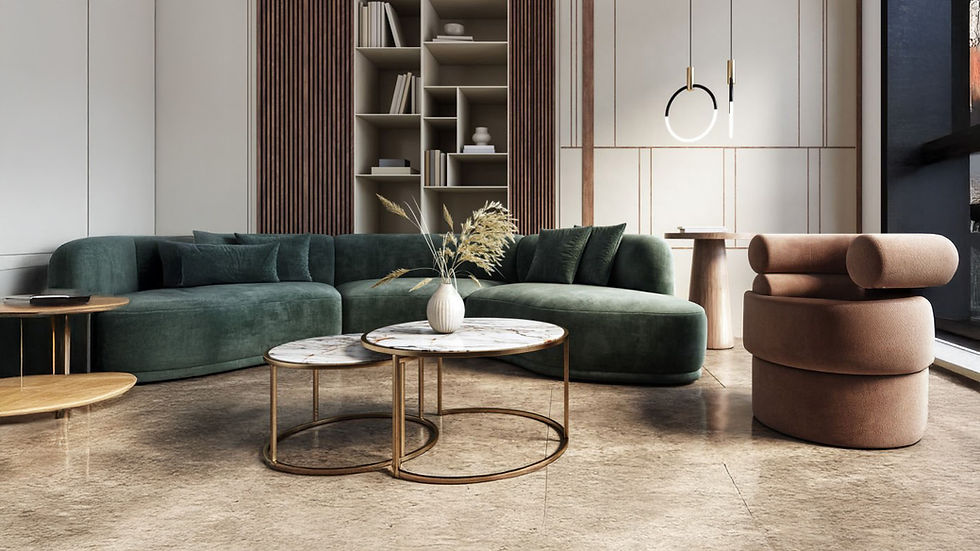How Smart Workspace Design Boosts Productivity
- Urbane Team

- Aug 11
- 9 min read
Updated: Aug 14

We’ve all been there, watching the clock while waiting for the workday to end. However, what if your office inspired you to do more? Smart workplace design isn’t just about aesthetics; it fuels motivation, creativity, and efficiency. So, let’s break free from the 9-to-5 time trap and explore how a smart workspace design boosts productivity.
Understanding Workspace Design and Its Variants

When people think of workspace design, they often picture a typical office with neatly arranged desks and chairs, but it goes far beyond that. It’s about creating an environment where one feels comfortable, motivated, and equipped to excel.
But what exactly makes a workspace “smart,” and why do different workspace designs exist? Let’s dive into the psychology behind workspace design and explore its various types.
The Psychology Behind Workspace Design

Your workspace is an extension of your mind. A cluttered, poorly lit, or uncomfortable workspace can lead to distractions, stress, and reduced efficiency, while a well-thought-out design can enhance concentration, motivation, and job satisfaction.
Several key design elements play a crucial role in shaping an individual’s productivity and well-being to create an effective workspace. Here are a few of them:
1. Cognitive Load Reduction: A well-organized space minimizes decision fatigue and mental clutter, making it easier to focus on tasks.
2. Ergonomics and Physical Comfort: Proper seating, desk height, and screen placement help maintain posture, reducing strain and discomfort.
3. Lighting and Mood: Natural light exposure is linked to improved mood and higher energy levels, while harsh artificial lighting can cause fatigue.
4. Color Psychology: Different colors evoke various emotions. For example, blue enhances focus, green encourages relaxation, and yellow stimulates creativity.
5. Nature and Biophilic Design: Incorporating plants, wooden textures, or nature-inspired elements can reduce stress and improve cognitive function.
Why Do Different Types of Workspace Designs Exist?

Workspaces are not one-size-fits-all. Companies and individuals adopt different workspace designs based on work styles, company culture, and industry requirements. Some of the most common workspace designs include:
Workspace Design | Key Features |
Open-Plan Workspaces | a. Encourage collaboration and communication. b. Popular in startups and creative industries. c. Can be noisy and distracting without designated quiet zones. |
Private Offices | a. Ideal for focused, high-concentration work. b. Suitable for executives, legal professionals, and analysts. c. Limits spontaneous collaboration. |
Hybrid Workspaces | a. Blend open and private spaces to cater to diverse work needs. b. Includes meeting pods, breakout areas, and quiet zones. c. Provides flexibility while maintaining productivity. |
Co-Working Spaces | a. Shared spaces designed for freelancers, remote workers, and startups. b. Offer networking opportunities and flexible memberships. c. Can lack personalization and consistency in work environments. |
Remote/Home Workspaces | a. Personalized for individual work preferences. b. Requires ergonomic furniture and proper lighting for maximum productivity. c. Can blur the boundary between work and personal life. |
Activity-Based Workspaces | a. Based on their needs, one can either choose quiet zones for deep work or open lounges for brainstorming. b. Provides autonomy and adaptability. c. Requires a structured approach to prevent inefficiencies. |
Each of these workspace designs serves a unique purpose, ensuring that individuals can work efficiently in an environment tailored to their needs, whether it's a corporate setting, a home office, or a dynamic co-working space. The right design can make a significant impact on productivity and well-being.
Must-Have Elements Of A Smart Workspace Design That Boosts Productivity
A smart workspace design strikes a balance between aesthetics and functionality, enhancing your productivity and creativity. Here are the key elements of an efficient and dynamic workspace:
1. Ergonomic and Adaptive Furniture

How often do you shift around in your chair, leaning forward and back, still unable to find a comfortable spot? Your back starts to ache, your hip flexors stiffen, and your neck grows sore from working at a desk that’s just not right for you. By the time you stand up, your body practically screams for relief.
While this scenario might seem trivial, ignoring your body's signals is far worse. Unfortunately, this is the everyday reality for most of us. An ergonomic workspace isn’t just about comfort. It directly impacts productivity, health, and overall well-being. When you feel valued and physically at ease, you’re far more likely to give your 100% to the company.
2. Seamless Technology Integration

You deserve a workspace that works for you and not against you. A truly smart workspace eliminates inefficiencies, ensuring that every task flows effortlessly. High-speed Wi-Fi and intuitive digital interfaces for seamless business correspondence are just the starting point.
Advanced technology is revolutionizing the way we work, making operations more efficient and intuitive. AI-powered automation, cloud-based collaboration platforms, and integrated smart systems streamline workflows, reducing manual effort and enhancing real-time communication. From voice-activated assistants that manage schedules to IoT-enabled devices that optimize environmental settings, every technological element contributes to a workspace that adapts to your needs.
By leveraging cutting-edge tools, your workspace transforms into a hub of innovation, one that fosters creativity, minimizes distractions, and empowers you to achieve more with less effort.
3. Optimized Space Plan
A smart layout doesn’t just maximize space; it transforms it, creating an environment that feels open and unrestricted. After all, no one enjoys feeling boxed in. Even if you’re not claustrophobic, a cramped space can subtly increase stress and reduce focus. High ceilings, ample natural light, and thoughtful furniture placement invite brightness and airflow, making the room feel refreshing.
When designing a workspace, every detail matters. Furniture that blends comfort with efficiency can make all the difference. Silent drawers, seamless storage solutions, and smooth-gliding cabinets may seem like small details, but they enhance functionality effortlessly, ensuring the space works with you, not against you.
4. Smart Lighting

Lighting plays a crucial role in shaping your mood, productivity, and energy levels. Whether too bright or too dim, improper illumination can lead to discomfort and decreased efficiency. You need optimal lighting conditions to perform at your best, and issues like flickering bulbs, inadequate brightness, or outdated fixtures can significantly hinder your focus and well-being. Addressing these concerns is essential for a truly smart workspace.
The ideal solution lies in flexible, adaptive lighting that adjusts to individual workstations and personal preferences. Smart lighting systems equipped with modern technology can automatically regulate brightness based on natural light levels, reducing eye strain and minimizing fatigue.
5. Climate Control
A well-regulated office climate is essential for fostering productivity and employee comfort. According to a 2019 study published in PLOS One, temperature directly impacts work performance, with women generally preferring warmer environments and men favoring cooler temperatures. This underscores the need for a balanced climate that accommodates diverse preferences.
Smart workspaces leverage advanced Heating, Ventilation, and Air Conditioning (HVAC) systems to maintain optimal temperature and humidity levels. These intelligent climate control solutions adapt in real-time, ensuring a comfortable atmosphere that enhances focus, efficiency, and overall well-being. By preventing extreme fluctuations, they minimize discomfort, reduce fatigue, and create an environment where employees can perform at their best.
6. Acoustic and Noise Management

One of the biggest productivity killers in any workspace is noise. Whether it's the constant buzz of colleagues chatting, the ringing of phones, or the jarring sounds of construction outside, these distractions not only break focus but also contribute to stress and mental fatigue. Ultimately, this leads to a decline in overall efficiency.
A well-designed smart workspace prioritizes acoustic control through advanced soundproofing solutions, noise-absorbing materials, and strategically placed quiet zones. Incorporating acoustic panels, double-glazed windows, and specialized ceiling treatments can significantly reduce ambient noise, fostering a more serene and focused environment.
Additionally, you can install designated silent areas or sound-masking technology to ensure that you can work without disruptions, enhancing concentration, productivity, and overall job satisfaction.
7. Collaborative and Private Work Zones
A smart workspace should support both solo work and group collaboration, as the combination of individual effort and teamwork drives a business's success. Striking the right balance requires thoughtful design and planning.
Open areas encourage spontaneous interaction and idea-sharing, fostering a dynamic and creative atmosphere. At the same time, private spaces provide a quiet, distraction-free environment for focused tasks that require deep concentration.
A well-designed workspace ensures that you can seamlessly transition between working independently and engaging with colleagues, maximizing both productivity and efficiency.
8. Personalized Workspace

Productivity isn't just about having the right tools. It's about creating an environment where you, as an employee, can feel at ease and inspired. One of the most effective ways to achieve this is by encouraging personalization. Whether it's family photos, quirky desk accessories, or decor in your favorite color palettes, allowing you to tailor your workstation and making the space feel more familiar and inviting.
This simple shift has a powerful psychological impact. When an individual feels free to express their personality, they naturally become more engaged, motivated, and creative. A personalized workspace blurs the line between the professional and the personal, creating a balanced setting that promotes focus and fulfillment. It's not just about comfort, but it's about cultivating a space where people want to do their best work.
9. Hybrid Work and Remote Connectivity

Gone are the days when office design was a one-time setup based solely on present needs. However, today’s dynamic work culture demands much more. With hybrid models and remote collaboration becoming the norm, smart workspaces must be built with adaptability at their core.
A truly productive smart workspace is one that seamlessly supports both in-office and remote teams. This means integrating high-speed connectivity, cloud-based collaboration tools, and flexible layouts that can shift as team needs evolve.
Whether employees are at their desks, working from home, or logging in from a different time zone, a well-connected workspace ensures everyone stays engaged, aligned, and productive. It's no longer just about where you work; it's about how effortlessly you can connect and contribute from anywhere.
10. Biophilic Design and Natural Elements

Just close your eyes and imagine sunlight piercing through tree canopies, filtering into your office through floor-to-ceiling windows. The serene rustle of leaves becomes a natural soundtrack, while pockets of greenery breathe life into every corner of the space. It's more than just visually soothing; this environment is scientifically proven to elevate mood, enhance focus, and reduce stress.
Smart workspaces embrace biophilic design not as a passing trend but as a core principle. A lack of natural light, stale air, and sterile interiors can leave you feeling drained and uninspired. But by weaving in elements like indoor plants, organic textures, natural airflow, and access to outdoor views, an office transforms from a place you have to be into a space where you want to thrive. A touch of nature doesn’t just enhance the ambiance; it becomes a quiet, powerful partner in boosting creativity, clarity, and overall well-being.
11. Color Psychology

Colors aren’t just visual details; they’re silent influencers that shape how we feel, think, and perform. In a smart workspace, color isn’t chosen at random; it’s intentionally used to cultivate focus, spark creativity, and create an emotionally balanced environment.
Take blue, for example, widely recognized for its calming presence, it helps promote clarity and sustained concentration. Pair it with shades of green, and you introduce a sense of harmony and renewal, perfect for fueling creative thinking throughout a busy day. On the other hand, accents of yellow can uplift energy, while touches of warm neutrals provide grounding and comfort.
So, it's safe to say that the right color palette doesn’t just make a space look good; it quietly powers motivation, reduces stress, and keeps productivity flowing.
12. Relaxation Zones

You wouldn’t expect your phone to run all day without charging, so why expect that from yourself? The most productive minds know when to pause. No matter how driven or focused you are, pushing through nonstop eventually leads to burnout.
That’s where smart workspace design steps in. By creating room for recovery, whether it’s a cozy lounge, a quiet pod, or simply a space to breathe, you build in moments that matter. These pauses aren’t a luxury; they’re a strategy. A quick reset can spark fresh ideas, elevate your mood, and help you return to your desk more energized and effective than before.
Are You Ready to Make Your Workspace Smart?
In the end, a smart workspace design is more than just visual appeal, as it’s about shaping experiences, enhancing mental well-being, and building a culture of productivity. Whether you're redesigning an office or creating one from scratch, integrating these thoughtful elements can transform your workplace into a thriving, people-first environment.
FAQs
Q. What is the link between workspace design and employee motivation?
A thoughtful workspace shows employees they’re valued, which boosts motivation. Comfort, light, and layout all contribute to a more engaged mindset.
Q. How does workspace design influence collaboration?
Open areas encourage casual teamwork while breakout spaces support focused discussions. Good design makes collaboration feel natural and easy.
Q. Can design impact how people manage their time at work?
Yes, defined zones for different tasks help people transition smoothly and stay on track throughout the day.
Q. How does noise control play into productivity?
Too much noise distracts, while total silence can feel uncomfortable. Smart acoustic choices create a balanced environment for focus.



Comments